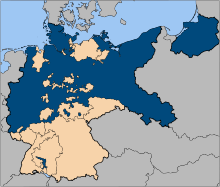
Back ولاية بروسيا الحرة Arabic Estáu Llibre de Prusia AST Вольная дзяржава Прусія Byelorussian Свободна държава Прусия Bulgarian Stad dieub Prusia Breton Estat Lliure de Prússia Catalan Svobodný stát Prusko Czech Fristaten Preussen Danish Freistaat Preußen German Ελεύθερο Κράτος της Πρωσίας Greek
| Free State of Prussia Freistaat Preußen | |||||||||||||
|---|---|---|---|---|---|---|---|---|---|---|---|---|---|
| State of Germany | |||||||||||||
| 1918–1947 | |||||||||||||
 The Free State of Prussia in 1925 | |||||||||||||
| Capital | Berlin | ||||||||||||
| Area | |||||||||||||
• 1925[1] | 292,695.36 km2 (113,010.31 sq mi) | ||||||||||||
| Population | |||||||||||||
• 1925[1] | 38,175,986 | ||||||||||||
| History | |||||||||||||
| Government | |||||||||||||
| • Type | Republic | ||||||||||||
| • Motto | Gott mit uns "God with us" | ||||||||||||
| Reichsstatthalter | |||||||||||||
• 1933–1935 | Adolf Hitler | ||||||||||||
• 1935–1945 | Hermann Göring | ||||||||||||
| Minister-President | |||||||||||||
• 1918 (first) | Friedrich Ebert | ||||||||||||
• 1933–1945 (last) | Hermann Göring | ||||||||||||
| Legislature | State Diet | ||||||||||||
• Upper Chamber | State Council | ||||||||||||
• Lower Chamber | House of Representatives | ||||||||||||
| Historical era | Interwar/World War II | ||||||||||||
| 9 November 1918 | |||||||||||||
| 30 November 1920 | |||||||||||||
| 20 July 1932 | |||||||||||||
| 30 January 1933 | |||||||||||||
| 30 January 1935 | |||||||||||||
| 25 February 1947 | |||||||||||||
| |||||||||||||
| Today part of | Germany Poland Russia Lithuania | ||||||||||||
The Free State of Prussia (German: Freistaat Preußen) was an internal territory of the former German Empire, established in 1918 per conventions of territorial simplification after the defeat of the First World War.
Regarded still as the dominant state of the newly-founded Weimar Republic, the Free State retained the capital of Berlin. Boasting a mostly pro-republican seating, it was regarded as the beacon of democracy in post-war Germany – even proving much more stable than the Weimar itself. For most of the republic's presidency, the Prussian ministries provided a candidate via the early forms of the modern-day Social Democratic Party (Sozialdemokratische Partei Deutschlands).
With a crisis unfolding in the 1932 elections that converted the Weimar into the German Reich, the Prussian coup d'etat instigated by Reichskanzler Franz von Papen at the request of the Reich's president Paul von Hindenburg sealed the fate of the Free State upon total failure, destroying an obstacle for the aspiring politician Adolf Hitler – whom had campaigns ongoing – to reach his role of leadership over the Reich. Papen's goal had been to establish a "new state" that would preserve the monarchy lost after the war, instead, he had weakened the Federalist constitution that kept the Weimar to some level of stability.
The Freistaat remained under the leadership of Hermann Goering from 1933 to 1945. Upon the defeat of Nazi Germany and surrender of commanding forces to both Soviet and Western Allies, the entity remained existent until its dissolution, recognized legally, took place on February 25th, 1947.
- ↑ Beckmanns Welt-Lexikon und Welt-Atlas. Leipzig / Vienna: Verlagsanstalt Otto Beckmann. 1931.

